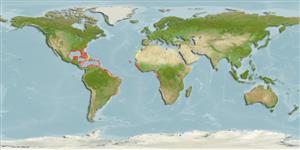Actinopterygii (ray-finned fishes) >
Anguilliformes (Eels and morays) >
Ophichthidae (Snake eels) > Myrophinae
Etymology: Myrophis: Greek, myros, -ou = male of morey eel + Greek, ophis = serpent (Ref. 45335).
Environment / Climate / Range
Ecology
Marine; brackish; demersal. Tropical, preferred ?
Eastern Atlantic: Senegal to Congo. Western Atlantic: Suriname, French Guiana, south to Brazil (Ref. 26938).
Size / Weight / Age
Maturity: Lm ? range ? - ? cm
Max length : 46.5 cm TL male/unsexed; (Ref. 4455); common length : 35.0 cm TL male/unsexed; (Ref. 4455)
Short description
Morphology | Morphometrics
Pale tan to gray with tiny black spots, abruptly darker above. Dorsal fin origin closer to gill opening than to anus (Ref. 26938).
Burrows in mud or sand in shallow waters of bays and estuaries (Ref. 4455). Inshore brackish and freshwater (Ref. 26938).
Life cycle and mating behavior
Maturity | Reproduction | Spawning | Eggs | Fecundity | Larvae
Leiby, M., 1990. Ophichthidae. p. 176-192. In J.C. Quero, J.C. Hureau, C. Karrer, A. Post and L. Saldanha (eds.) Check-list of the fishes of the eastern tropical Atlantic (CLOFETA). JNICT, Lisbon; SEI, Paris; and UNESCO, Paris. Vol. 1. (Ref. 4455)
IUCN Red List Status (Ref. 115185)
CITES (Ref. 94142)
Not Evaluated
Threat to humans
Harmless
Human uses
More information
Common namesSynonymsMetabolismPredatorsEcotoxicologyReproductionMaturitySpawningFecundityEggsEgg development
Age/SizeGrowthLength-weightLength-lengthLength-frequenciesMorphometricsMorphologyLarvaeLarval dynamicsRecruitmentAbundance
ReferencesAquacultureAquaculture profileStrainsGeneticsAllele frequenciesHeritabilityDiseasesProcessingMass conversion
Tools
Special reports
Download XML
Internet sources
